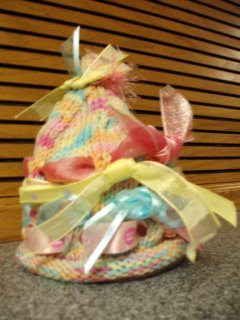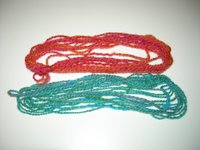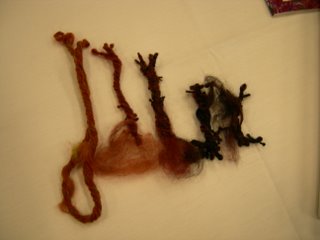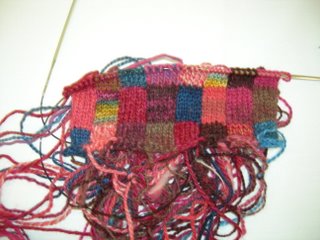Friday, December 29, 2006
Internet Radio Website
You enter an artist or song you would like to hear and it searches the internet for that song and songs similar to that and makes your very own private radio station for you. Is that not cool?
My favorites so far have been Blondie and Norah Jones but the possibilities are endless. Haven't tried any classical music yet. Hmmmm. Gotta love it!
Sunday, November 26, 2006
Saturday, November 25, 2006
Baby Hat and more!
For those of you who couldn't make it to the last spin in here is a picture of the hat I made for a friend's grandaughter.
 The next pictures are of a felted bag that I finished for a friend of mine. Denise died last June of pancreatic cancer. She had started this bag for her daughterinlaw. Jen has it now and I hope it will make many trips to the library with her.
The next pictures are of a felted bag that I finished for a friend of mine. Denise died last June of pancreatic cancer. She had started this bag for her daughterinlaw. Jen has it now and I hope it will make many trips to the library with her. OK I can't figure out how to post another picture so I'll send this and then add more pictures later.

Monday, November 20, 2006
Spin-In News
Other than that catastrophe, a good time was had by all (at least by me). Show and tell was fabulous and I hope some of you will post your pictures.
Heather brought her dyed roving and the colors were yummy! Take a look.
She helped me (er….she did most of the work, I’ll have to admit) with a
She also had some Austrian fingering weight rag yarn in red/black called Steinbach. I will have to add some to my stash. I think this is it.
Jillian brought tons of show and tell. She had some dynamo apple green (?) roving that she shared with some of us. She brought a sweater that she had designed. I tried it on and, ladies, I could barely convince myself to give it back to her...Seriously. So, I guess I’ll just have to wait until the pattern comes out. Sigh….
She also brought 3 or 4 newly acquired spindles. We drooled. Yes, indeed. Sweet!
Post a couple pics, Jillian??
CJ’s roving was an unpredictably delicious surprise. She spun a yellowy-peach that she thought was going to be too pale but it ended up going great with Jillian’s apple green and an outstanding paprika.. Show your colors, girl!
PS. CJ is graduating with her Masters in Public Policy in December. Stand up and take a bow, CJ. Woo-Hooo!!!!!
Carol brought some equally wonderful colors. She formed a trio of lapis blue with some of Jillian’s apple green and CJ’s paprika. What was your complementary color, Carol? All those colors are just creating an explosion in my mind. Whoa!
Carol made the cutest baby hat. PahLLEEZE take a picture and post it before you give it away, Carol?
Holly Dawg had an amazing time poking her nose in everybody’s bags and baskets. I daresay she was dreaming about sheep in her doggie dreams that night.
We’re looking at some night between January 23-28 for our next spin-in. Please email me if you have a preference. Adios for now. Mary
Monday, November 06, 2006
Dyed locks

I have some fleeces in the garage that need to get on to the next phase in life, so I dyed one up for the project. Mary was gracious enough to take pictures of my samples so I could post them here. Now I have another reason to buy a digital camera....
Several people in our spinning group asked if I could post my instructions on how I dyed my samples. Because I used food color paste, I decided to write a pretty detailed account because I was not able to find this level of instruction elsewhere. There is plenty of information on how to use Sabraset, Jacquard, Cushing, and other commercial acid dyes, so I ended up with an amalgamation of those techniques along with my experiments.
Here goes:
Immersion Dyeing Techniques
2 gallons water in stainless steel stockpot
2 cups white vinegar
8 oz. fiber (yarn or locks)
Dishwashing liquid
Kitchen thermometer (must show up to 200 degrees)
Food color gel paste
Colors used for this project are below:
Yellow – Wilton brand, Lemon Yellow, half container.
Violet – Cake Craft brand, Super Violet, 1 container.
Blue – Cake Craft brand, Royal Blue, 1 container.
Darker blue – Cake Craft brand, Super Navy Blue,1 container.
Orange – Cake Craft brand, October Orange, 1 container.
Overview of techniques
Soak fiber.
Make up dye solution.
Fill dyepot with water, vinegar and dye solution.
Add wetted fiber and bring up to temperature.
Let cool, rinse thoroughly, and dry.
Detailed techiques
I followed these generally accepted fiber preparation steps: Add a few drops of dishwashing liquid to a large container (bucket, bowl, etc.) of tepid water. Put the fiber into the water and make sure there’s enough water to cover well. Soak the fiber for at least an hour.
While the fiber soaked, I made up the dye solution. I emptied the contents of the food coloring paste into a mason jar and mixed with the hottest water from my tap until completely dissolved. To ensure the dye was completely incorporated, I let it stand until the fiber was ready.
When the fiber had been completely wetted (1-2 hours), I filled the stockpot with 2 gallons of water the same temperature as the soaking water. I added the white vinegar and the dye solution, stirring well with a plastic chopstick. In later batches with very dark colors, I partially filled the stockpot, added the dye solution, and then rinsed out the jar by repeatedly filling with water and pouring it into the stockpot.
I lifted the wet fiber out of its water and let it drain. Then I placed it in the stockpot and gently pushed it around until all had been submerged.
Note that adding more than 8 oz. of fiber risks that the fiber will not dye evenly. I found that this was an advantage when dyeing locks because the color has more depth when combing them out later. Violet and blue both struck unevenly. The other colors were fine. When I used blue and violet with a test batch using yarn, I had no problems with uneven color. The amount of fiber was less than the amount of locks I used in later batches however, so I assume this was the cause.
I slowly brought the temperature up to a near boil, occasionally stirring the fiber to make sure the water had the same temperature at the top of the pot as at the bottom. I have a gas stove and began with the dial set at medium until the temperature reached about 150 degrees. Then I moved the dial to medium high until the temperature was 175 degrees. At that point, I set the dial to almost the highest setting and let the temperature reach 200 degrees.
I noticed that the lighter colors struck significantly between 190 and 195 degrees. The darker colors needed to go to 200 before being taken up into the fiber. The fiber seemed to swell the last ten degrees of heating, so this is an indicator the end of the dyeing is near. I also found that the temperature in the pot rises quickly between 195 and 200 degrees, so you much watch the fiber closely.
At that point, I turned off the heat and let the pot cool. For the first few batches, I let the pot cool to room temperature on the stove, which took at least 6 hours. Being the impatient person I am, in later batches I let the pot cool for about 2 hours inside, and then put the pot outside to cool. The outdoor temperature was in the 50s and after I checked 2 hours later, it was cooled down enough to rinse.
I carefully lifted the fiber out of the pot and placed it in a bucket with clear water of the same temperature. After gently pushing the fiber around, I let it soak for about 10 minutes and then repeated the process until it was nearly clear. I found it took 4-6 rinse cycles to get a clear rinse; darker colors took more cycles. For some batches, I put some Eucalan into the final rinse cycle. For other batches, I put the Eucalan in earlier rinses, but there wasn’t any noticeable difference in results.
To dry the fiber, I gently squeezed out as much water as I could. I spread newspapers out on the floor in front of a heating vent in my kitchen, put a sweater drying frame over it, and lay the locks/yarn on top of that, turning occasionally until dry.
Again, my impatience led to a new discovery. I let the fiber dry until barely damp and then put it directly on the newspaper. It dried much more quickly because it was directly in front of the vent instead of slightly above it. In the future, I will experiment with putting down a towel in front of the vent and laying the fiber on it, bypassing the sweater frame entirely. The cotton toweling should help wick away the moisture from the fiber, but the large surface area should allow for speedy evaporation.
Tuesday, October 24, 2006
Camera's Opinion
Mary's Nine Patch
Monday, October 23, 2006
Yardage Estimations
Sunday, October 22, 2006
Heather's color thoughts
Last week, I stared at the color wheel trying to make my color choices. I wanted to choose colors that would challenge me in some way--I hate them or they simply aren't what I usually use in my projects. Surprisingly, none of the colors on the wheel fell into either one of these categories.
In the end, I chose violet for #1 because I like deep purple, but I tend to shy away from lighter/pastel versions of it. Blue is #2 because it is a good complement to the other colors I chose. Orange is #3 because it can be a challenge to control the hue.
Yellow is #4 because it will force me to discipline my dyeing technique to make it lemon or butter yellow instead of a deep yellow orange. For #5, I will thoroughly blend black with the orange because the outcome seemed like the most unpredictable for me. Blue lightly blended (maybe even just layered) with white will be #6. I've been spinning some layered batts lately and I liked the effect I got from it.
For #7, blue and orange will be plied together. I think I'll try a square with the straight colors and a square with the black/orange blend. Violet and yellow plied together will be for #8. While I enjoy working with color in general, this combination is probably the one I consciously avoid the most, especially the lighter shades. Lastly, violet and blue plied together is for the #9 square because I'm curious how a strong blue and a lighter purple will look together. I may end up plying a strand of blue/white and the violet together for an extra square.
I've got some washed locks sitting around and it would be a good de-stashing exercise to dye them up to make these samples. My hope is that this project will give me a lot more confidence with both dyeing and blending base colors into new and different yarns.
My dyeing experience has been based exclusively on Kool-Aid and food color paste using small quantities of finished yarns. It will be interesting to see how locks respond to the dyes and how I have to adjust my dyeing techniques to account for the difference in the physical volume of fiber.
Hope I haven't bitten off more than I can chew...!
Tuesday, October 17, 2006
Tuesday, September 26, 2006
Friday, September 22, 2006


Trying to be true to my color wheel triad, I needed a yellow orange and a red violet that I didn't have in my painted roving. I decided to blend them. The red violet was pretty close to begin with but since it was a solid color, I decided to blend in some of my painted roving to give it some color high lights and make it more "not solid", like the other yarns.

If you're buying a painted roving or painting your own, you may want to think about staple length and color repeats. If your color repeat is shorter than your fiber length, it will be difficult to get enough fibers to spin a relatively pure color in a repeat. If you want a variety of color or a heathered color, the shorter color repeats are fine. Some one jump in and comment on this section. I have a feeling I didn't explain it adequately. Here's a picture that might help.
- Be sure you have signed up for your 9-patch. We need two more people to complete the puzzle.
- You may use anything from your own stash.
- Yarn should be spun approximately DK weight (final yarn that you knit with should be approximately 10-12 wpi)
- Each small square in the 9-patch should measure 3 inches square when it is completed. The 9-patch will be 9 inches square.
- Use stockinette stitch except that 2 squares should incorporate a textured (knit-purl) stitch.
- Knit squares using the intarsia method (rather than separate squares sewn together).
- Each number is assigned a color. Squares 1-3 will be the 3 colors you have chosen from your stash. #1 should be in the red to violet family, #2 should be in the blue to green family and #3 should be in the yellow to orange family. #4 should be a complementary color to either #1, #2 or #3. #5-7 should use white, gray or black to blend with any of the first 4 colors (ie white + #2, #4 blended with white, gray and black, any combination you can think of, which can also include a plying technique instead of blending fibers before spinning). #8-9 should be 2 combinations of 2 of any of the first 4 colors blended or plied together.
- If you have a great idea that doesn't fall into the above classifications, knit a separate square to lay on top of your 9 patch or someone else's to change the look of the 9-patch. (Hope that made sense). Just one or two extra squares, not a complete 9-patch.
- We will try to meet November 2nd, 16th, 17th, 18th or 19th. Email me with your preferences for a day.
Wednesday, September 13, 2006
Step 2
Next, pick a complementary color to one of the 3 colors you've chosen. A complementary color is the color directly across the color wheel (ie red and green). Then check to see if you have a little gray, white and/or black roving for your palette.
Monday, September 11, 2006
Su Doku Grid - Sign Up For Your 9-Patch
Saturday, September 02, 2006
Wednesday, August 30, 2006
Spinning for Entrelac
Can any experienced blogger tell me why these top three rows of my post are underlined like a link? :{

Sunday, August 27, 2006
Spinning for Intarsia
What a Grrrrooovy Lynne Vogel Workshop!
Just finished a fabulous 3 day spinning for intarsia and entrelac workshop taught by Lynne Vogel (of Twisted Sister Sock Book fame). It was a real creativity stretcher and I loved every minute (except when I tried to roll my active singles into a center pull ball and INSTANTLY discovered fiber spaghetti....not recommended). I'll post a few pictures in the next couple of days.



















